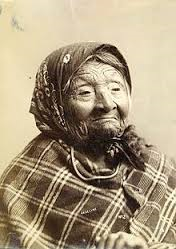Great Woman: Angeline of the Duwamish, 1820-1896
There is a long-running stereotype that daughters of Native chiefs and leaders are royalty entitled to the title of princess. However, most Native tribes in North America did not have a concept of royalty and royal titles. While women in a tribe played important roles, and individual chiefs' daughters might have risen to positions of respect with their people, they held no specific title within their tribe.
Seattle, 1786-1866, was a leader of the Suquamish and Duwamish people of what is now Washington. The city of Seattle was named in his honor. Throughout much of his life, he pursued a policy of cooperation and co-existence with Whites. However, in 1855, he was ordered to take his people to a reservation, something he stalwartly refused to do. He would later move to Agate Passage, but would frequently visit the town ironically named for him. Later in life, he converted to Roman Catholicism, as did his daughter, Kikisoblu, who was given the Angeline. Angeline was born to Seattle in what is now Rainier Beach, Seattle. She lived her life in the area and was in her 40's when, in 1855, he father was ordered to remove the Duwamish to a reservation. Though Seattle and most of his people later moved to Agate Passage, Angeline remained in Seattle. She lived in a cabin on the waterfront near what is now Pike Place Market, supporting herself by doing laundry and selling handwoven baskets. She died in May, 1896, but not before she had met a young photographer named Edward S. Curtis. Angeline's would be the first photograph of a Native person that Curtis would take in his own remarkable career.
Seattle, 1786-1866, was a leader of the Suquamish and Duwamish people of what is now Washington. The city of Seattle was named in his honor. Throughout much of his life, he pursued a policy of cooperation and co-existence with Whites. However, in 1855, he was ordered to take his people to a reservation, something he stalwartly refused to do. He would later move to Agate Passage, but would frequently visit the town ironically named for him. Later in life, he converted to Roman Catholicism, as did his daughter, Kikisoblu, who was given the Angeline. Angeline was born to Seattle in what is now Rainier Beach, Seattle. She lived her life in the area and was in her 40's when, in 1855, he father was ordered to remove the Duwamish to a reservation. Though Seattle and most of his people later moved to Agate Passage, Angeline remained in Seattle. She lived in a cabin on the waterfront near what is now Pike Place Market, supporting herself by doing laundry and selling handwoven baskets. She died in May, 1896, but not before she had met a young photographer named Edward S. Curtis. Angeline's would be the first photograph of a Native person that Curtis would take in his own remarkable career.




Comments
Post a Comment